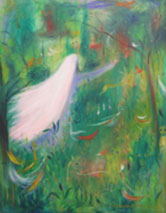
Feliciano Béjar
Mexican, 1920-2007
A su huerto hubo de bajar mi amado (My Beloved Has Gone Down to His Orchard), 1964
oil on canvas
35 1/2 x/26 in.
SBMA, Gift of Ruth Watkins Ackerman from the Collection of Harold and Fannie Watkins
2009.44

Undated photo of Feliciano Béjar

A view through a Béjar Magiscope
COMMENTS
Feliciano Béjar was a self-taught Mexican painter and sculptor born in Jiquilpan, Michoacán, Mexico. At the age of 8, Bejar suffered from polio, so he was forced to use crutches for almost five years. At that time he learned various arts, which was encouraged by his mother.
Feliciano Bejar is known for his experimental sculpture using metal, crystal, plastic, and stained glass. He is also a set designer and architect, and in the nineties turned to landscape development, restoring a piece of land in his native Mexico. Bejar has had one-man shows world-wide and his work is represented in the collections of the Museum of Modern Art, New York, Dartmouth College, the Biblioteque Nationale, Paris, and many other collections.
Bejar explains his magiscope sculptures: “Some distort, some define, but always they give us a new vision. As their generic name indicates, they are instruments to see magically, to see the magic and poetry that exists all around us all the time, but that our indifferent eyes do not wish to perceive.”
http://mexicoart.org/2011/06/22/feliciano-bejar-1920-2007/
SBMA CURATORIAL LABELS
Feliciano Béjar was a self-taught artist born to a working-class family in Jiquilpan, Michoacán, whose career spanned painting, sculpting, printmaking, and set design. In 1943, the artist moved to New York City where he spent his days studying works of art at the Metropolitan Museum of Art while supporting himself as a window dresser at night.
The untimely death of Béjar’s adopted daughter in 1961 had a profound effect on the artist, who went into temporary mystic reclusion at a monastery in Cuernavaca. When he returned to painting, Béjar revisited Christian imagery and stories that were ever-present in his youth. The title of this work is adapted from a nineteenth-century Spanish translation of the “Song of Songs” from the Old Testament, which traces the courtship between husband and wife. The ghostly figure is perhaps a reference to his departed daughter. Capturing light—viewed by the artist as a life-giving force—was central to many of the works produced throughout his long career.
The lush and verdant landscape depicted here points to Béjar’s lifelong commitment to combating deforestation. In 1964, the artist attempted to form an environmental protection society in Mexico City but was met with deaf ears.
- SBMA title card, 2013
